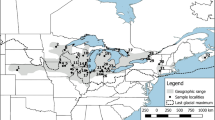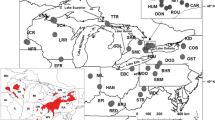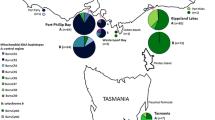Abstract
For species living in naturally fragmented habitats, the identification of conservation units is particularly challenging. Turks and Caicos Rock Iguanas, Cyclura carinata, are endemic to the Turks and Caicos Islands (TCI). These Critically Endangered lizards inhabit less than 5% of their historic range. A complete study of the geographic distribution of genetic variation is now particularly important for this species due to the onset of translocation programs. To fill this knowledge gap, we genotyped 280 individuals from 30 sampling locations across the species range were genotyped at 29 microsatellite loci, and variation within the mitochondrial ND4 gene was assessed by sequencing, or the use of PCR-RFLPs. A protein profiling analysis of femoral pore secretions was also conducted on a subset of samples. Microsatellites suggest that a recent, common population ancestry, or a simple reduction in gene flow, cannot account for the significant differences detected between a western and an eastern lineage within the TCI (Fct = 0.202, p ≪ 0.01). The same pattern was confirmed by mitochondrial DNA sequence, significantly distinguishing between the western and eastern haplotypes (Φct = 0.96, p ≪ 0.01). Protein profiling provides further support, differentiating a western and eastern lineage. Implications of these results are that at least two evolutionarily significant units (ESUs) can be recognized across this taxon’s geographic range. Multiple management units, within each ESU, can also be defined. Future management planning for C. carinata should consider these evolutionarily independent lineages.



Similar content being viewed by others
References
Aiello CM, Nussear KE, Walde AD et al (2014) Disease dynamics during wildlife translocations: disruptions to the host population and potential consequences for transmission in desert tortoise contact networks. Anim Conserv 17:27–39
Alberts AC (1990) Chemical properties of femoral gland secretions in the desert iguana, Dipsosaurus dorsalis. J Chem Ecol 16:13–25
Alberts AC (1991) Phylogenetic and adaptive variation in lizard femoral gland secretions. Copeia 1991:69–79
Alberts AC (1993) Chemical and behavioral studies of femoral gland secretions in iguanid lizards. Brain Behav Evol 41:255–260
Allendorf FW, Luikart G (2007) Conservation and the genetics of populations. Wiley, New York
An J, Sommer JA, Shore GD et al (2004) Characterization of 20 microsatellite marker loci in the west Indian rock iguana (Cyclura nubila). Conserv Genet 5:121–125
Arevalo E, Davis SK, Sites JW (1994) Mitochondrial DNA sequence divergence and phylogenetic relationships among eight chromosome races of the Sceloporus grammicus complex (Phrynosomatidae) in Central Mexico. Syst Biol 43:387–418.
Auffenberg W (1982) Feeding strategy of the Caicos ground iguana. In: Iguanas of the world: their behavior, ecology and conservation. Noyes Publications, Park Ridge
Bryan JJ, Gerber GP, Welch ME, Stephen CL (2007) Re-evaluating the taxonomic status of the Booby Cay Iguana, Cyclura carinata bartschi. Copeia 2007:734–739
Chapuis MP, Estoup A (2007) Microsatellite null alleles and estimation of population differentiation. Mol Biol Evol 24:621–631
Clement M, Posada D, Crandall KA (2000) TCS: a compuer program to estimate gene genealogies. Mol Ecol 9:1657–1660
Cochran DM (1935) Herpetological collections from the West Indies made by Dr. Paul Bartsch under the Walter Rathbone Bacon scholarship, 1928–1930. Smithson Misc Collect 92:1–47.
Colosimo G, Knapp CR, Wallace LE, Welch ME (2014) Inferred vs realized patterns of gene flow: an analysis of population structure in the Andros Island Rock Iguana. PLoS ONE 9:e106963
Craton M (1986) A history of the Bahamas. San Salvador Press, San Salvador
Darriba D, Taboada GL, Doallo R, Posada D (2012) jModelTest 2: more models, new heuristics and parallel computing. Nat Methods 9:772–772
Dempster AP, Laird NM, Rubin DB (1977) Maximum likelihood from incomplete data via the EM algorithm. J R Stat Soc Ser B 39:1–38
Dodd CK, Seigel RA (1992) Relocation, repatriation, and translocation of amphibians and reptiles: are they conservation strategies that work? Biol Conserv 62:336–350
Earl DA, vonHoldt BM (2012) STRUCTURE HARVESTER: A website and program for visualizing STRUCTURE output and implementing the Evanno method. Conserv Genet Resour 4:359–361.
Efremov VV (2006) The rule of “one migrant per generation” and genetic differentiation in subdivided populations. Zh Obshch Biol 67:198–205.
Estoup A, Jarne P, Cornuet JM (2002) Homoplasy and mutation model at microsatellite loci and their consequences for population genetics analysis. Mol Ecol 11:1591–1604
Evanno G, Regnaut S, Goudet J (2005) Detecting the number of clusters of individuals using the software STRUCTURE: a simulation study. Mol Ecol 14:2611–2620
Excoffier L, Smouse PE, Quattro JM (1992) Analysis of molecular variance inferred from metric distances among DNA haplotypes: application to human mitochondrial DNA restriction data. Genetics 131:479–491
Excoffier L, Laval G, Schneider S, Lischer HEL (2010) Arlequin (version 3.5): an integrated software package for population genetics data analysis. Evol Bioinform Online 10:564–567
Fairbanks RG (1989) A 17,000-year glacio-eustatic sea level record: influence of glacial melting rates on the Younger Dryas event and deep-ocean circulation. Nature 342:637–642
Felsenstein J (2005) Theoretical evolutionary genetics joseph felsenstein. University of Washington, Seattle
Fraser DJ, Bernatchez L (2001) Adaptive evolutionary conservation: towards a unified concept for defining conservation units. Mol Ecol 10:2741–2752
Funk DJ, Omland KE (2003) Species-level paraphyly and polyphyly: frequency, and consequences, with insights from animal mitochondrial DNA. Annu Rev Ecol Syst 34:397–423
Funk WC, McKay JK, Hohenlohe PA, Allendorf FW (2012) Harnessing genomics for delineating conservation units. Trends Ecol Evol 27:489–496
Gerber GP (2004) Cyclura carinata. The IUCN Red List of threatened species. 10.2305/IUCN.UK.2004.RLTS.T6026A12317199.en Accessed 16 Oct 2015
Gerber GP (2007) Turks and Caicos iguana translocation program, Bahama Archipelago. In: Soorae PS (ed) Re-introduction News. Newsletter of the IUCN/SSC Re-Introduction Specialist Group, Abu Dhabi, UAE. IUCN/SSC Re-Introduction Specialist Group, Abu Dhabi, p 53
Gerber GP, Iverson J (2000) Taxonomic account for the Turks and Caicos iguana, Cyclura carinata. In: Alberts AC (ed) West Indian Iguanas: status survey and conservation action plan. IUCN, Gland Switzerland, pp 15–18
Gerber GP, Pagni L (2012) Turks and Caicos Iguana: conservation and managment plan 2005–2009. IUCN, Gland Switzerland
Gilbert KJ, Andrew RL, Bock DG et al (2012) Recommendations for utilizing and reporting population genetic analyses: the reproducibility of genetic clustering using the program structure. Mol Ecol 21:4925–4930
Greig JC (1979) Principles of genetic conservation in relation to wildlife management in Southern Africa. S. Afr. J Wildl Res 9:57–78.
Griffith B, Scott JM, Carpenter JW, Reed C (1989) Translocation as a species conservation tool: status and strategy. Science 245:477–480
Grismer LL (1994) Geographic origins for the reptiles on islands in the gulf of California, México. Herpetol Nat Hist 2:17–40.
Grismer LL (2002) Spiny-tailed Iguanas, insular evolution and Seri Indians: how long does it take to make a new species and does it matter who makes it? Iguana Times 9:3–8.
Guo SW, Thompson EA (1992) Performing the exact test of Hardy–Weinberg proportion for multiple alleles. Biometrics 48:361–372
Hanski I (1991) Single-species metapopulation dynamics: concepts, models and observations. Biol J Linn Soc 42:17–38.
Hanski I (1998) Metapopulation dynamics. Nature 396:41–49
Hedges SB (1996) The origin of west indian amphibians and reptiles. In: Powell R, Henderson R (eds) Contribution to West Indian herpetology: a tribute to Albert Schwartz. Society for the Study of Amphibians and Reptiles, Ithaca, pp 95–127
Hedges SB (2006) An overview of the evolution and conservation of West Indian amphibians and reptiles. Appl Herpetol 3:281–292.
Hower LM, Hedges SB (2003) Molecular phylogeny and biogeography of West Indian Teiid Lizards of the Genus Ameiva. Caribb J Sci 39:298–306.
ITWG (2016) A checklist of the iguanas of the world (Iguanidae; Iguaninae). In: Iverson JB, Grant TD, Knapp CR, Pasachnik SA (eds) Iguanas: biology, systematics, and conservation. Herpetological conservation and biology 11 (Monograph 6), ITWG, New York 4–46
Iverson JB (1978) The impact of feral cats and dogs on populations of the West Indian rock iguana, Cyclura carinata. Biol Conserv 14:63–73
Iverson JB (1979) Behavior and ecology of the rock iguana (Cyclura carinata). Bullettin Florida State Museum. Biol Sci 24:175–358.
Iverson JB (1982) Adaptations to herbivory in guanine lizards. In: Burghardt GM, Rand AS (eds) Iguanas of the world: their behavior, ecology and conservation. Noyes Publications, Ridge Park
Iverson JB (1985) Lizards as seed dispersers? J Herpetol 19:292–293
Jensen JL, Bohonak AJ, Kelley ST (2005) Isolation by distance, web service. BMC Genet 6:13
Jombart T (2008) adegenet: a R package for the multivariate analysis of genetic markers. Bioinformatics 24:1403–1405
Jombart T, Devillard S (2010) Discriminant analysis of principal components: a new method for the analysis of genetically structured populations. BMC Genet. doi:10.1186/1471-2156-11-94
Keegan WF (1992) The people who discovered Columbus: the prehistory of the Bahamas. University Press of Florida, College Park
Knapp CR (2005) Working to save the Andros Iguana. Iguana 12:9–13.
Knapp CR, Malone CL (2003) Patterns of reproductive success and genetic variability in a translocated Iguana population. Herpetologica 59:195–202
Kolbe JJ, Glor RE, Rodríguez Schettino L et al (2004) Genetic variation increases during biological invasion by a Cuban lizard. Nature 431:177–181
Laemmli UK (1970) Cleavage of structural proteins during the assembly of the head of bacteriophage T4. Nature 227:680–685
Lau J, Alberts AC, Chemnick LG, et al (2009) Isolation and characterization of 23 polymorphic microsatellite loci for a West Indian iguana (Cyclura pinguis) from the British Virgin Islands. Mol Ecol Resour 9:1412–1414.
Lighty RG, Macintyre IG, Stuckenrath R (1982) Acropora palmata reef framework: a reliable indicator of sea level in the Western Atlantic for the past 10,000 years. Coral Reefs 1:25–30
Longmire JL, Gee GF, Hardekopf CL, Mark GA (1992) Establishing paternity in whooping cranes (Grus americana) by DNA analysis. Auk 109:522–529
Losos JB, Ricklefs RE (2009) Adaptation and diversification on islands. Nature 457:830–836
Malone CL, Wheeler T, Taylor JF, Davis SK (2000) Phylogeography of the Caribbean rock iguana (Cyclura): implications for conservation and insights on the biogeographic history of the West Indies. Mol Phylogenet Evol 17:269–279
Malone CL, Knapp CR, Taylor JF, Davis SK (2003) Genetic consequences of Pleistocene fragmentation: Isolation, drift, and loss of diversity in rock iguanas (Cyclura). Conserv Genet 4:1–15
Martin JL, Knapp CR, Glenn P et al (2015) Phylogeography of the endangered lesser antillean Iguana, Iguana delicatissima: A recent diaspora in an archipelago known for ancient herpetological endemism. J Hered 106:1–7
Meirmans PG (2012) The trouble with isolation by distance. Mol Ecol 21:2839–2846
Mitchell N, Haeffner R, Veer V, et al (2000) Cat eradication and the restoration of endangered iguanas (Cyclura carinata) on Long Cay, Caicos Bank, Turks and Caicos Islands, British West Indies. Specialist 206–212.
Moritz C (1994a) Defining “evolutionarily significant units” for conservation. Trends Ecol Evol 9:373–375
Moritz C (1994b) Applications of mitochondrial-Dna analysis in conservation—a critical-review. Mol Ecol 3:401–411
Moritz C (1999) Conservation units and translocations: Strategies for conserving evolutionary processes. Hereditas 130:217–228
Moritz C (2002) Strategies to protect biological diversity and the evolutionary processes that sustain it. Syst Biol 51:238–254.
Moritz C, Cicero C (2004) DNA barcoding: promise and pitfalls. PLoS Biol 2:e354
Olesen JM, Valido A (2003) Lizards as pollinators and seed dispersers: an island phenomenon. Trends Ecol Evol 18:177–181
Palsbøll PJ, Bérubé M, Allendorf FW (2007) Identification of management units using population genetic data. Trends Ecol Evol 22:11–16
Peakall R, Smouse PE (2012) GenAlEx 6.5: Genetic analysis in Excel. Population genetic software for teaching and research-an update. Bioinformatics 28:2537–2539
Peer K, Taborsky M (2005) Outbreeding depression, but no inbreeding depression in haplodiploid Ambrosia beetles with regular sibling mating. Evolution 59:317–323
Pérez I, Anadón JD, Díaz M et al (2012) What is wrong with current translocations? A review and a decision-making proposal. Front Ecol Environ 10:494–501
Pritchard JK, Stephens M, Donnelly P (2000) Inference of population structure using multilocus genotype data. Genetics 155:945–959
Puechmaille SJ (2016) The program structure does not reliably recover the correct population structure when sampling is uneven: subsampling and new estimators alleviate the problem. Mol Ecol Resour 16:608–627.
Raymond M, Rousset F (1995) GENEPOP (version 1.2): population genetics software for exact tests and ecumenicism. J Hered 86:248–249
Reynolds RG, Gerber GP (2012) Ecology and Conservation of the Turks Island Boa (Epicrates chrysogaster chrysogaster: Squamata: Boidae) on Big Ambergris Cay. J Herpetol 46:578–586
Reynolds RG, Gerber GP, Fitzpatrick BM (2011) Unexpected shallow genetic divergence in Turks Island Boas (Epicrates c. chrysogaster) reveals single evolutionarily significant unit for conservation. Herpetologica 67:477–486
Reynolds RG, Niemiller ML, Fitzpatrick BM (2012) Genetic analysis of an endemic archipelagic lizard reveals sympatric cryptic lineages and taxonomic discordance. Conserv Genet 13:953–963
Ridley M (2003) Evolution, 3rd Edition. Blackwell Science, Ltd, New York
Rodda GH, Bock BC, Burghardt GM, Rand AS (1988) Techniques for identifying individual lizards at a distance reveal influences of handling. Copeia 1988:905–913
Rosas KG, Pérez-Buitrago N, Acevedo JP, et al (2008) Development and characterization of 11 microsatellite loci for the Mona Island iguana (Cyclura cornuta stejnegeri). Mol Ecol Resour 8:825–827.
Rousset F (2008) GENEPOP’007: a complete re-implementation of the GENEPOP software for Windows and Linux. Mol Ecol Resour 8:103–106.
Rozen S, Skaletsky H (2000) Primer3 on the WWW for general users and for biologist programmers. Methods Mol Biol 132:365–386
Rubinoff D (2006) Utility of mitochondrial DNA barcodes in species conservation. Conserv Biol 20:1026–1033
Ryder OA (1986) Species conservation and systematics: the dilemma of subspecies. Trends Ecol Evol 1:9–10
Sadler HE (1997) Turks island landfall: a history of the Turks and Caicos Islands. Private Printing
Schwartz A, Carey M (1977) Systematics and evolution in the West Indian iguanid genus Cyclura. Stud Fauna Curacao Caribb Islands 53:15–97.
Simmonds PL (1877) The economic uses of reptiles. J R Soc Arts
Switzer RC, Merril CR, Shifrin S (1979) A highly sensitive silver stain for detecting proteins and peptides in polyacrylamide gels. Anal Biochem 98:231–237
Tamura K, Peterson D, Peterson N et al (2011) MEGA5: molecular evolutionary genetics analysis using maximum likelihood, evolutionary distance, and maximum parsimony methods. Mol Biol Evol 28:2731–2739
Taylor BL, Dizon AE (1999) First policy then science: why a management unit based solely on genetic criteria cannot work. Mol Ecol 8:S11–S16
Templeton AR, Crandall KA, Sing CF (1992) A cladistic analysis of phenotypic associations with haplotypes inferred from restriction endonuclease mapping and DNA sequence data. III. Cladogram estimation. Genetics 132:619–633
Toscano MA, Macintyre IG (2003) Corrected western Atlantic sea-level curve for the last 11,000 years based on calibrated 14C dates from Acropora palmata framework and intertidal mangrove peat. Coral Reefs 22:257–270
Van Oosterhout C, Hutchinson WF, Wills DPM, Shipley P (2004) MICRO-CHECKER: Software for identifying and correcting genotyping errors in microsatellite data. Mol Ecol Notes 4:535–538
Vucetich JA, Waite TA (2000) Is one migrant per generation sufficient for the genetic management of fluctuating populations. Anim Conserv 3:261–266
Waits L, Taberlet P, Swenson JE et al (2000) Nuclear DNA microsatellite analysis of genetic diversity and gene flow in the Scandinavian brown bear (Ursus arctos). Mol Ecol 9:421–431
Waples RS, Gaggiotti O (2006) What is a population? An empirical evaluation of some genetic methods for identifying the number of gene pools and their degree of connectivity. Mol Ecol 15:1419–1439
Weir BS (1996) Genetic data analysis II: methods for discrete population genetic data. Sinauer Assoc Sunderland, Sunderland
Weir BS, Cockerham CC (1984) Estimating F statistics for the analysis of population structure. Evolution (N Y) 38:1358–1370.
Welch ME (1997) The population genetic structure of Cyclura carinata carinata. University of Tennessee, Knoxville
Welch ME, Gerber GP, Davis SK (2004) Genetic Structure of the Turks and Caicos Rock Iguana and its implication for Species Conservation. In: Alberts AC, Hayes WK, Martins EP (eds) Iguanas, biology and conservation. University of California Press, Berkeley
Welch ME, Long GJ, Berk JW, et al (2011) Twenty-nine polymorphic microsatellite loci in Cyclura carinata, the Turks and Caicos Iguana, a critically endangered island endemic. Conserv Genet Resour 3:209–212.
Whitlock MC, McCauley DE (1998) Indirect measures of gene flow and migration: Fst ≠ 1/(4 N m + 1). Heredity (Edinb) 82:117–125.
Wright S (1931) Evolution in Mendelian populations. Bull Math Biol 52:241–295
Acknowledgements
We would like to thank Dr. Russello and two anonymous reviewers for insightful comments that contributed to the significant improvement of this manuscript. We thank the Turks and Caicos National Trust (TCNT), which provided financial support for fieldwork and sample collection through a grant from the U.K. Foreign and Commonwealth Office. Ken Wiley provided logistic assistance and coordinated travel arrangements in the Turks and Caicos Islands. The Department of Environmental and Coastal Resources of the Turks and Caicos Islands Government provided transportation to many of the uninhabited cays. Kelly Bradley and Rachel Hayward assisted with fieldwork and sample collection in the TCI, and Joe Wasileski, Steve Connors, and John Bendon provided assistance on Booby Cay; all deserve special thanks. Laboratory work was conducted at and supported by San Diego Zoo Institute for Conservation Research, Mississippi State University (MSU), University of Tennessee, Knoxville, and Utah Valley University. Shackouls Honors College, Mississippi EPSCOR, and North East Mississippi Daily Journal provided support for undergraduate researchers at MSU.
Author information
Authors and Affiliations
Corresponding author
Additional information
Mark E. Welch and Giuliano Colosimo contributed equally to the writing of this manuscript.
Electronic supplementary material
Below is the link to the electronic supplementary material.
Rights and permissions
About this article
Cite this article
Welch, M.E., Colosimo, G., Pasachnik, S.A. et al. Molecular variation and population structure in critically endangered Turks and Caicos Rock Iguanas: identifying intraspecific conservation units and revising subspecific taxonomy. Conserv Genet 18, 479–493 (2017). https://doi.org/10.1007/s10592-016-0922-6
Received:
Accepted:
Published:
Issue Date:
DOI: https://doi.org/10.1007/s10592-016-0922-6




